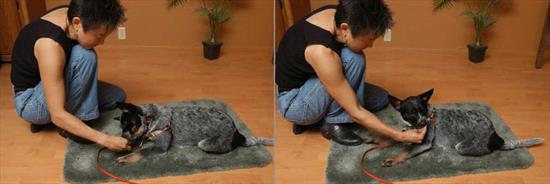Training your dog to perform tricks is not only fun but the tricks can also be used to put the pooch into both a happy and calm state. Here’s one example of such a trick—called “Bang.” With this trick, when you say “bang” or some other cue word or give a visual cue (such as pointing your finger like a gun), your dog will plop down on her side and lie motionless until you give her the verbal “ok” to get up. If you practice this trick a lot with family members and friends, you may find that when your pooch is excited and wants attention or treats, she will be more likely to lie on her side instead of jumping or barking for attention!
Step 1: Start with a tasty semi-moist treat shaped such that you can let her gnaw little bits off. Or use a series of small tasty hard treats that you can give sequentially. Hold the treat right up to her nose in a position that causes here to turn her head slightly. Once she’s finished with the treat, remove your hand and start again.
Step 2: Once she will consistently turn her head to get the treat while remaining lying down, place the treat a little further back such that she has to turn her head more. For some dogs you have to break this stage down into many steps because if you turn their head too much, they feel off balance and just get up. The goal is to turn it just enough so that they will remain lying down until they realize it’s just easier to turn their back hip and lay further on their side. Again, once you are finishing the treat, remove your hand and then repeat the step.
Step 3: Once your dog is lying completely on her side, keep the treats coming continuously such that your hand is always holding treats right up to her nose and she doesn’t have a chance to get up. Try to keep her in position receiving treats for 5–10 seconds so that she has a chance to relax into that position. When she’s finished with the treats, remove your hand and repeat step 3.
Step 4: Once she’s lying down more stably on her side, space out the treats instead of giving them continuously. That is, while you’re giving your string of treats with your hand right up at her nose, quickly pull your hand away from her nose but keep your treat hand down low so you don’t lure her to get up. Then, before she decides that she should get up, move the treat hand back up to her face and give her another treat. See if you can get 5–10 treats to her in this manner and systematically have her wait longer and longer between treats. Then give the ok for her to get up and repeat steps 3 and 4. Make sure that you always set the situation up such that you give the “ok” before she gets up so that she learns to hold her position until you give that release word.
Your dog may automatically start offering to lie on her side when she sees a treat. Most dogs get to this point within several 10–15 minute sessions. Once they have been rewarded a lot for lying on their sides, they may even start to offer the behavior automatically when they see that you have a treat. If you are working on this exercise and your dog automatically lies on their side without a food lure, then be sure to reward her as instructed in step 4.
When can you add the cue word? You are ready to add the cue when you dog either automatically lies down on her side unsolicited when she sees you have a treat or when you know she will immediately roll onto her side when you use the food lure. Here’s what you do:
Step 5a: For the dog who will immediately roll over on her side when you use the food lure, before presenting the lure, say “bang” while making a “gun” with your fingers. Then immediately follow by luring her with the treat so that that she rolls onto her side. Reward her with a short series of treats and extend the time between treats so that she learns to lay patiently.
Step 5b: For the dog who rolls onto her side automatically, say “bang” and give the hand cue immediately before you think she will roll onto her side, then wait a few seconds to give her a chance to roll onto her side if she doesn’t immediately do so. If she fails to lie on her side, try one more time. If she fails again, then work more on just rewarding her when she automatically lies on her side OR use step 5a. Avoid saying the cue word in situations where she does not perform the behavior immediately or you will teach her to ignore your cue word.
Step 6: Practice this trick in different rooms, on different surfaces, outdoors, in the park, at your friend’s house, when guests are over, on walks. Each location and context is a little different. So, if you want your dog to perform the tricks reliably in many situations, you’ll need to go through steps 4 and 5 in other contexts.
Once your pooch has the trick down, you’ll have a fun reliable trick to help put Fido in a happy mood and simultaneously keep her calm.








